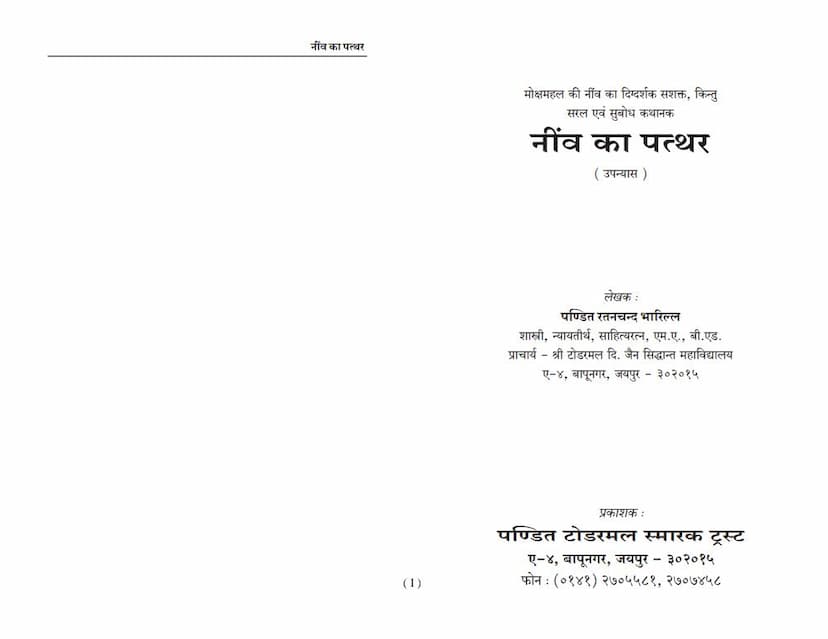Neev Ka Patthar
Added to library: September 2, 2025

Summary
"Neev ka Patthar" (The Foundation Stone) by Pt. Ratanchand Bharilla is a novel that delves into the core principles of Jain philosophy, presented through an engaging narrative. The book aims to illuminate the path to moksha (liberation) by explaining fundamental Jain doctrines in a simple and understandable manner.
The novel follows the life journey of Jivaraj, a character whose life is marked by significant ups and downs, ultimately leading him to the path of spiritual liberation.
Key themes and plot points include:
- The Centrality of "Vastu Swatantrya" (Object Independence): This is identified as the "foundation stone" of the "Moksha Mahal" (Palace of Liberation). The principle asserts that every entity, including oneself and all other objects, exists and functions independently, without being the cause or effect of another. This concept is explained through the idea of "Shad-Karak" (six causal factors) and "Chaar Abhav" (four negations/absences). Understanding this principle is crucial for shedding attachment and aversion.
- Jivaraj's Moral and Spiritual Journey: Jivaraj's life illustrates the practical application and consequences of adhering to or deviating from Jain principles.
- He experiences worldly pleasures and temptations, notably through the character of Mohini, which lead him astray, resulting in financial ruin and personal degradation.
- His first wife, Samta, embodies patience, wisdom, and unwavering devotion. Despite Jivaraj's failings, she remains steadfast and supportive, ultimately guiding him back to the righteous path. Her character highlights the importance of virtuous conduct and spiritual fortitude in overcoming adversity.
- Jivaraj's sons, Virag and Jyotsna, also play significant roles in the narrative, reflecting the impact of parental upbringing and the ongoing spiritual journey of the family. Virag, in particular, grapples with understanding true Dharma versus mere ritualistic observance.
- The Role of Karma: The novel depicts karma as an impartial force, personified as Karmkishor. Karmkishor, though a non-sentient entity, is portrayed as faithfully administering the consequences of Jivaraj's actions, rewarding good deeds and punishing wrongdoings, thus illustrating the Jain concept of karma's impartial operation.
- The Meaning of True Dharma: The book emphasizes that true Dharma is not just external rituals or adherence to practices but the internal transformation of one's inner disposition. This is illustrated through Virag's realization that mere adherence to religious practices without understanding their underlying principles doesn't lead to liberation from inner turmoil.
- The Concept of "Nimit" (Instrumental Cause): The novel clarifies that external factors, people, or events (like Mohini or even one's karma) are merely instrumental causes (nimitta) and not the ultimate doers or controllers of one's destiny. The true cause lies within one's own internal disposition and choices. This is reinforced through discussions on "Nimit Upadan" (instrumental and material cause) and the independence of each substance.
- The Significance of "Sarvagyata" (Omniscience) and "Krambaddhparyay" (Chronologically Ordered Manifestations): These concepts are presented as foundational to understanding "Vastu Swatantrya." The omniscience of Tirthankaras provides the framework for the predetermined, yet independently occurring, sequence of events in the universe. Understanding this leads to equanimity and freedom from worry and blame.
- The Importance of Righteous Conduct and Understanding: The narrative showcases the transformative power of genuine spiritual understanding and practice. Jivaraj's eventual realization and embrace of Jain principles, guided by Samta, lead him to a state of peace and eventual liberation.
- Social and Familial Harmony: The novel also touches upon family dynamics, particularly the challenges and triumphs in relationships, exemplified by Jyotsna's exemplary conduct in her marital home, earning the respect and admiration of her in-laws. This section highlights the practical application of Jain ethics in social interactions.
In essence, "Neev ka Patthar" serves as a spiritual guide disguised as a novel. It uses the life story of Jivaraj and his family to illustrate the profound Jain principles of Vastu Swatantrya, karma, right conduct, and the path to moksha, making complex philosophical concepts accessible and relatable to a wider audience. The book advocates for a deep understanding of these foundational principles to build a truly liberated life.